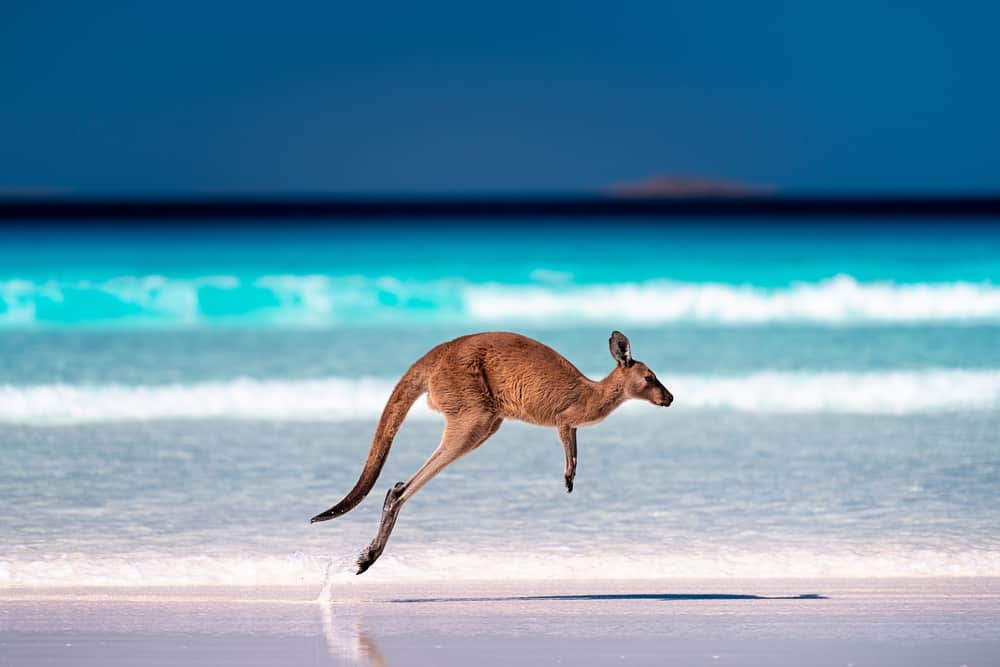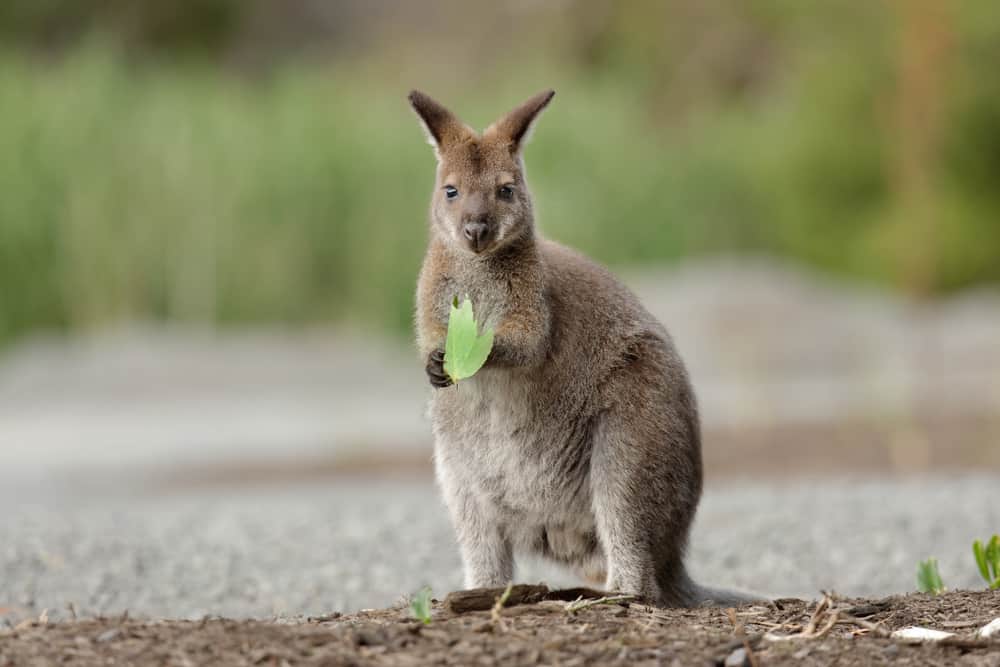Macropodidae is a family of marsupials commonly known as kangaroos, wallabies and their relatives. This diverse group of animals are found throughout Australia, New Guinea and nearby islands, with some species also introduced to other parts of the world.
Macropodidae has become an important subject in zoology research due to its unique adaptations for living in arid environments, including specialized hindlimbs for hopping, efficient water conservation mechanisms and complex social behaviors.
Macropodidae exhibits a wide range of body sizes, from the smallest musky rat-kangaroo weighing only 300g to the largest red kangaroo that can reach up to 90kg. These herbivorous marsupials have evolved remarkable anatomical features such as elongated hind legs and tail, reduced forelimbs and large feet adapted for powerful jumping locomotion over long distances at high speed.
The reproductive system of macropods is also fascinating, with females possessing two uteri and producing relatively underdeveloped young which continue their growth outside the womb attached to teats in the mother’s pouch.
In this article, we will explore the taxonomic diversity, geographic distribution and ecological significance of Macropodidae by reviewing recent scientific literature on these iconic Australian mammals.

Genera
- Genus Dendrolagus – tree-kangaroo
- Genus Dorcopsis
- Genus Dorcopsulus
- Genus Lagorchestes – hare-wallaby
- Genus Lagostrophus – banded hare-wallaby
- Genus Macropus – gray kangaroos
- Genus Osphranter – red kangaroo, antilopine kangaroo, wallaroos
- Genus Notamacropus – wallabies
- Genus Onychogalea – nail-tail wallaby
- Genus Setonix – quokka
- Genus Thylogale – pademelons
- Genus Wallabia – swamp wallaby
Taxonomic Classification And Diversity Of Macropodidae
Macropodidae is a family of marsupials commonly known as kangaroos, wallabies, and tree-kangaroos. This group exhibits diverse morphology and ecology with more than 70 extant species distributed across Australia, New Guinea, Indonesia, and nearby islands.
Among mammals, macropods are considered one of the most successful groups in terms of adaptation to various habitats and climatic conditions. The evolutionary history of Macropodidae dates back to at least 20 million years ago during the Late Miocene period. Fossil records suggest that early macropods were cursorial animals adapted for running on open ground rather than hopping like their modern counterparts.
Subsequent diversification resulted in adaptations such as arboreal lifestyles and grazing habits. Due to human activities such as hunting and habitat destruction, several species of macropods have become endangered or critically endangered. Conservation efforts include captive breeding programs, habitat restoration projects, and protection from poaching. Despite these initiatives, many populations continue to face threats due to climate change and other anthropogenic factors.
Geographic Distribution And Habitat Preferences
Having established the taxonomy and diversity of Macropodidae, it is now necessary to examine their geographic distribution and habitat preferences.
These marsupials are found primarily in Australia and nearby islands such as New Guinea, but some species have also been introduced to other parts of the world such as Europe.
Within these regions, macropods occupy a diverse range of habitats from open grasslands to dense forests.
Despite their adaptability, many species face threats due to human activities such as habitat destruction and hunting.
Migration patterns among macropods vary depending on the species and location.
Some populations may migrate seasonally to take advantage of food availability or breeding opportunities while others remain largely sedentary throughout the year.
Competition with other herbivores can also play a role in determining migration patterns as well as habitat use.
For example, in areas where livestock graze alongside wild herbivores like kangaroos, there may be increased competition for resources leading to changes in behavior or even population declines.
Understanding these complex relationships between macropods and their environment is crucial for conservation efforts aimed at protecting these iconic Australian animals.
Adaptations For Arid Environments
The arid environments that macropodidae inhabit have shaped their unique adaptations to survive in conditions with limited resources. These adaptations include specialized physical and behavioral traits aimed at conserving water while seeking out food sources.
To begin, the kangaroo’s powerful hind legs are adapted for long distance travel across vast landscapes where water is scarce. They hop instead of walk, which allows them to conserve energy and reduce heat production.
Furthermore, hiding behavior is another important adaptation used by macropodidae to avoid direct sunlight and minimize dehydration. During the day when temperatures are high, these marsupials rest or hide under shade to prevent water loss through sweating or panting. Additionally, they also feed during early morning or late evening hours when humidity levels are higher and temperatures cooler.
Overall, these physiological and behavioral adaptations enable macropodidae species to thrive in harsh desert climates where other animals would struggle to survive without access to regular sources of water.
Anatomical Features For Efficient Hopping Locomotion
Adaptations for arid environments have been crucial in the evolution of macropodidae. These animals are primarily found in Australia’s dry and semi-arid regions, where water is scarce, and temperatures can reach unbearable levels. To survive in such harsh conditions, these marsupials have developed several adaptations like reduced metabolic rate, efficient kidneys that conserve water, and specialized teeth to extract moisture from their food.
However, one critical adaptation that enables them to thrive in the arid environment is their unique anatomical features. Macropods’ hopping locomotion is an energy-efficient method of moving around vast distances with minimal effort. To achieve this feat, they have evolved specific muscle structures and bone density that allow them to hop long distances without getting tired quickly.
Their hind legs are longer than their forelegs and are specially adapted for jumping off the ground forcefully. The muscles responsible for powering each jump attach directly onto the femur (thigh bone), which is thicker and denser than other leg bones. Additionally, studies show that kangaroos possess elastic tendons on their feet that act as springs during take-off while also providing stability during landing.
Overall, these modifications enable macropodidae to move swiftly through its environment with remarkable ease despite challenging terrain or hot climatic conditions.
Reproductive System And Life Cycle Of Macropods
The reproductive system and life cycle of macropods have been an area of interest for many researchers. Their unique behavior during reproduction has made them a fascinating subject to study.
Developmental stages in macropods are different from other mammals, which is why they require further research. Macropodidae undergoes a process of sexual maturity that varies between species; however, developmental changes occur at the same time across all members of the family.
The females give birth to underdeveloped young who continue their growth outside the womb by clinging onto their mother’s pouch until fully developed. Reproductive behavior plays a crucial role in this process as mating can only take place when the female is receptive, leading to successful fertilization and gestation period before giving birth.
Furthermore, environmental factors such as food availability affect their breeding cycles and success rates making it vital to understand these intricacies to conserve populations globally.

Ecological Significance Of Macropodidae In Australian Ecosystems
The reproductive system and life cycle of macropods have been extensively studied, revealing complex mating behaviors, gestational periods, and pouch development. However, understanding the ecological significance of this marsupial family is equally important in comprehending their role in Australian ecosystems.
One notable impact that macropodidae has on vegetation is through herbivory. As primarily grazers or browsers, they play a crucial role in shaping plant communities by controlling the growth rates and distribution patterns of various species.
Furthermore, interactions with predators are another aspect of macropod ecology that warrants attention. Many native carnivores rely on macropods as a primary food source, such as dingoes and Tasmanian devils. However, introduced predators like foxes and cats pose an additional threat to already vulnerable populations.
Understanding these predator-prey dynamics can also inform conservation efforts and management strategies for protecting both macropods and other species within their ecosystem.
Overall, investigating the ecological significance of macropodidae provides valuable insights into the interconnectedness of Australia’s unique fauna and flora.
In summary, while knowledge about the reproductive system and life cycle of macropods is essential for scientific understanding; it is equally critical to investigate how they interact with other organisms in their environment.
Macropod herbivory plays a crucial role in maintaining diverse plant communities throughout Australia’s varied habitats while serving as prey for many native carnivores who help regulate population sizes naturally.
By examining these two aspects together, researchers gain a more comprehensive view of how this fascinating marsupial family fits into its ecosystem holistically.
Conclusion
Macropodidae, commonly known as kangaroos and wallabies, are a family of marsupials found in Australia. With over 60 species, they exhibit remarkable diversity in morphology and ecology. Their unique adaptations for hopping locomotion make them iconic symbols of the Australian outback.
Most macropods inhabit open grasslands or woodlands across Australia, but some also occur in forests and mountains. They have evolved various physiological mechanisms to cope with arid environments such as water conservation and heat dissipation. Additionally, their hindlimbs are elongated and muscular while their forelimbs are relatively short which enables them to move efficiently on two legs.
The reproductive system of macropods is highly specialized with females having two separate uteri and an extended lactation period allowing young ones to grow within the pouch until fully developed. The life cycle of macropods can vary greatly between species depending on environmental conditions.
Macropodidae play important ecological roles in maintaining balance within Australian ecosystems through grazing patterns and seed dispersal. Despite being considered national icons by many Australians, human activities such as habitat loss and hunting pose significant threats to these fascinating creatures.
In conclusion, Macropodidae represent a unique group of animals that have adapted incredibly well to thrive in diverse environments throughout Australia. Their efficient hopping locomotion, specialized reproductive systems, and ecological importance make them a valuable subject for research into animal behavior and biology.
As we continue to learn more about these fascinating creatures, it becomes increasingly clear that their preservation is vital not only for the stability of Australian ecosystems but also for our own appreciation of nature’s wonders.

